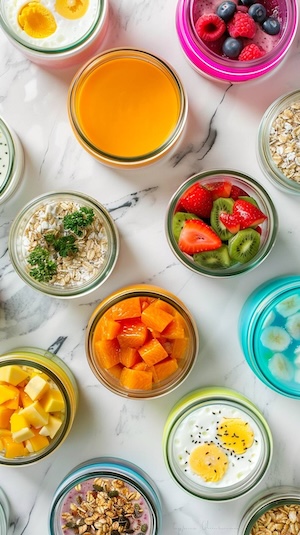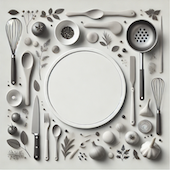Best Cereal for PCOS: Brands Ranked & Reviewed
Discover the best cereal for PCOS with our expert rankings. Compare brands, check ingredients, and find PCOS friendly cereal that supports hormonal balance.
My secret recipe for this delicious Korean favourite! Full instructions on my blog http://www.maangchi.com/recipe/baechu-doenjang-guk 'm so excited to introduce this simple and healthy soup to you! Korean meals are usually served with rice, soup, and other side dishes. Just in case you don't know what doenjang is, I'm telling you that doenjang is Korean fermented soy bean paste. You could make so many different kinds of doenjang guk using different vegetables such as spinach, potato, radish leaves, fresh mugwort (ssuk)... Of all the vegetables, baechu (napa cabbage) doenjang guk is the most basic soup and every Korean loves it. (Let me know if you find any Korean who doesn't like this soup) : ) I will give you a short quiz now. : ) What would you call doenjang guk made with spinach? ... pause ... yes, it's called shigeumchi doenjang guk. Shigeumchi is spinach in Korean. Heh, it's easy, right? When my grandmother made this soup, she always used milky rice water instead of water. Every day she made a huge amount of rice to feed her family. When she washed, rubbed, and rinsed her rice grains, she got the milky water. When she made doenjang guk, she used that milky rice water in her pot. When I was in middle school, the lady next door ran a restaurant. She sold baechu doenjang guk. She and my mother were friends, so we were like family. Most of her soup customers were male workers who needed a cheap and simple breakfast before starting work early in the morning. What time in the morning? Before dawn! To be ready to serve this soup, she probably should make it at 2-3 am? Her soup was very popular so that her restaurant was always crowded especially in the morning. I saw her serving her soup to her customers. When her customer was sitting at the table, she ladled the soup into a large bowl from her huge pot and added a little barley rice (about 2 tbs?), and put it on his table. Only one side dish was there, kkaktugi (radish kimchi). That's all! The worker's stomach will get warm with the hot soup and a little bit of rice! I used to wake up with the irresistible aroma from the soup she made. Sometimes the smell made me go crazy! : ) Her doenjangguk was not spicy and a little brown and milky. It was super tasty! I saw she used flour instead of rice water. She made this doenjang guk exactly this way I'm showing in this video recipe. Only thing I skipped is MSG. : ) Instead of MSG, I use more dried anchovies. I miss her now. We lost connection long time ago when my family moved to another place. Ingredients: 700 grams of Napa cabbage (half of a medium size napa cabbage), 1/3 cup soy bean paste, 10dried anchovies, 6 cups of water, 1 green chili pepper, 5-6 cloves of garlic, 2 tbs flour. Directions: 1.Put about 700 grams of Napa cabbage directly into boiling water and stir it with a large spoon for 20 seconds. Boil it for a minute with the lid open. 2. Rinse it in cold water a couple of times to clean any remaining dirt from the cabbage leaves. Gently squeeze the leaves to get rid of any remaining water. 3. Chop the cabbage into small pieces and put them into a large pot. 4. Add 1/3 cup soy bean paste, 5-6 cloves minced garlic, 1 chopped green chili pepper, 10 large dried anchovies (after removing heads and guts), and 2 tbs flour to the pot. 5. Mix it by hand or a wooden spoon. 6. Add 6 cups of water and bring to a boil for 20 minutes over medium high heat. 7. Lower the heat and simmer another 10 minutes. 8. Serve hot with rice and other side dishes. *tip: Do you like spicy soup? Then add some hot pepper paste right before simmering (step 7
This recipe includes superfoods such as:
Transform your health with tailored 7-day meal plans designed specifically for PCOS management. Just $7/month or $59/year.
Get it now →See video for ingredients
See video for instructions

You know the drill: Alarm goes off. You hit snooze. Rush around frantically. Skip breakfast AGAIN because there's no time. By 10am, you're hangry, your blood sugar is all over the place, and your PCOS symptoms are already acting up.
Sound familiar?
Finally – a meal prep system designed specifically for women with PCOS who refuse to let chaotic mornings derail their health goals.
In just ONE hour on Sunday, you can transform your entire week:
"I went from skipping breakfast 4 days a week to having delicious, hormone-supporting meals ready every morning. My energy is more stable and my cravings have disappeared!"
– Sarah M.
Stop letting chaotic mornings control your health.
Get your hormone-happy mornings starting this Sunday.
→ Get Your 60-Minute Solution Now
Transform your health with tailored 7-day meal plans designed specifically for PCOS management. Just $7/month or $59/year.
Get it now →Serving Size: 0
| Amount Per ONE Serving | ||
|---|---|---|
| Calories 0 kcal | ||
| Fat 0 g | ||
| Carbohydrate 0 g | ||
| Protein 0 g | ||
💡 Introducing the 10/10 PCOS Solution:
Ten Delicious Crockpot Recipes that take just 10 minutes to prep!
Say goodbye to hours in the kitchen and hello to clean, PCOS-friendly meals made effortlessly.
👉 Click here to grab your 10/10 PCOS Solution today! Try The 10/10 PCOS Solution: Ten Crockpot Recipes That Take Just Ten Minutes to Prep
Managing PCOS can be challenging, but you don't have to do it alone. Join our supportive community to connect with others who understand what you're going through, share tips, and get encouragement. Here's how you can get involved:
Subscribe to our Newsletter: Receive PCOS-friendly recipes, tips, research updates, and more delivered straight to your inbox. Stay informed and empowered with the latest information and support.
Join our Telegram Channel: Stay updated with the latest tips and advice on managing PCOS.
Follow PCOS Meal Planner on Facebook: Engage with our community, participate in discussions, and get support from others.
Break the cycle with the PCOS Meal Planner - your personalized guide to eating better, feeling better, and managing PCOS symptoms. Take control today!

Forget the frustrating cycle of weight loss attempts, endless medications, and living in discomfort. Introducing the PCOS Meal Planner. A meal planning guide that goes beyond temporary fixes to offer a comprehensive strategy, empowering you to ignite a transformation towards lasting health and happiness. Step into a world where you control your PCOS, not the other way around.
Unlock Your PCOS Freedom Now.
Discover the best cereal for PCOS with our expert rankings. Compare brands, check ingredients, and find PCOS friendly cereal that supports hormonal balance.
Learn how to transition away from fruit when starting a ketogenic diet for PCOS. Discover gradual strategies, fruit alternatives, and practical tips for success.
Discover 5 delicious PCOS banana bread recipes with low-glycemic ingredients. Learn how to make hormone-friendly banana bread that supports blood sugar balance.
Creatine for women with PCOS explained simply. Learn safety, benefits, hormone effects, tips, and how creatine may support PCOS symptoms naturally.
Complete PCOS diet plan with foods to eat, foods to avoid, meal timing, and real results. Learn the science-backed approach to managing PCOS through diet, with 7-day meal plan, grocery list, and step-by-step implementation guide. Based on clinical research and real patient outcomes.
Complete guide to ordering at Wendy's with PCOS. Discover the best protein-focused meals, what to skip, and how to customize orders to keep blood sugar stable. Learn which burgers, salads, and sides work for PCOS, plus complete macros for every menu item and smart swaps to avoid insulin spikes.
Complete guide to ordering at Burger King with PCOS. Discover the best protein-focused meals, what to skip, and how to customize orders to keep blood sugar stable. Learn which burgers, salads, and sides work for PCOS, plus complete macros for every menu item and smart swaps to avoid insulin spikes.
Discover 30+ delicious PCOS-friendly smoothie recipes that stabilize blood sugar and support hormones. Each recipe includes protein macros, glycemic load, and hormone-balancing ingredients. Find breakfast smoothies, post-workout options, green smoothies, and dessert alternatives - all designed to prevent insulin spikes while satisfying cravings.
Discover the best supplements for PCOS backed by clinical research. Learn which supplements improve insulin resistance, reduce androgens, support ovulation, and balance hormones. Complete guide with dosages, timing, brands, and what to avoid. Evidence-based recommendations for inositol, vitamin D, omega-3, berberine, and more.